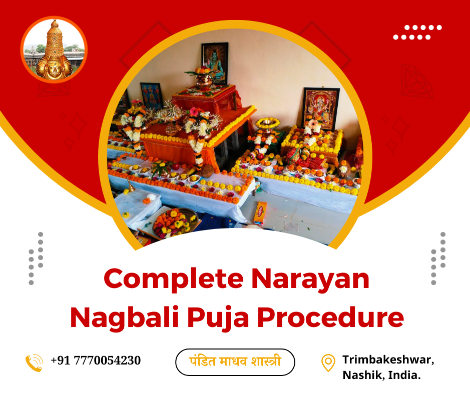
- January 1, 2025
- Pandit Madhav Shastri
- 0
Complete Narayan Nagbali Puja Procedure: Step-by-Step Guide
In Hindu tradition, certain rituals are considered essential not only for the well-being of an individual but also for the spiritual upliftment of their entire lineage. Narayan Nagbali Puja is one such powerful and sacred ritual, performed primarily at the Trimbakeshwar Jyotirlinga temple in Nashik, Maharashtra. It is performed to address unresolved ancestral karma, liberate souls of the departed, and remove doshas (spiritual afflictions) from one’s life.
Many devotees are aware of the name Narayan Nagbali but do not fully understand the procedure or how to perform it properly. In this comprehensive guide, we will walk you through every step of the Narayan Nagbali Puja, from preparation to completion. Whether you are planning to perform it yourself or simply want to understand its depth and significance, this guide will offer you clarity and insight.
What is Narayan Nagbali Puja?
Before diving into the procedure, it’s essential to know that Narayan Nagbali is a three-day ritual consisting of two main components:
Narayan Bali: Performed to satisfy and liberate the souls of ancestors who died unnatural deaths (accidents, suicide, etc.) and whose last rites were not properly done.
Nagbali: Conducted to atone for the sin of killing a cobra or serpent, intentionally or unintentionally. It also addresses Sarpa Dosha in one’s horoscope.
The puja is performed according to ancient Vedic scriptures, mainly the Garuda Purana, and requires strict adherence to prescribed steps. Let’s now break down the complete procedure.
Preparation Before the Puja
1. Selection of Place and Pandit
The most sacred and widely accepted place for this puja is Trimbakeshwar Temple, located in Nashik. It is advised to choose experienced Vedic Pandits who specialize in Narayan Nagbali rituals.
Contact the pandit a few days in advance
Book accommodation near the temple
Choose auspicious dates like Pitru Paksha, Amavasya, or recommended Tithis
2. Essential Items Required
Though most items are arranged by the pandit, you may be asked to bring:
Two sets of new traditional clothes (for men: dhoti and angavastra)
Coconut, betel leaves, betel nuts, rice, black sesame seeds
Silver or copper coins, flowers, camphor, incense
Wheat flour for making the snake and human effigies (Pind)
A cowrie shell (used symbolically)
Food items for feeding Brahmins and cows
Day 1: Narayan Bali Puja Procedure
Objective:
To liberate the soul of a deceased ancestor who died due to unnatural causes and may be stuck in the material world (preta yoni).
Step-by-Step Ritual:
1. Sankalp (Vow Taking)
The devotee takes a sankalp (vow) by holding water and flowers in their hands.
The priest recites mantras while invoking ancestors and deities.
2. Creation of Pind (Wheat Effigy)
A human figure made from wheat flour dough is created to represent the soul of the deceased.
Various body parts are sculpted and symbolized.
3. Ritual Bath and Dressing of the Pind
The effigy is bathed and dressed as per funeral rites.
This symbolizes the rebirth of the soul for the sake of ritual completion.
4. Offering Pind Daan
Pind Daan is performed using black sesame seeds, rice, ghee, and other sacred items.
The effigy is worshipped as the soul of the deceased.
5. Funeral Rites (Antyeshti)
A symbolic funeral is conducted including mantra chanting and cremation process using sacred fire.
The wheat effigy is burned with camphor and sandalwood, symbolizing the release of the soul.
6. Tarpan (Water Offering)
Water mixed with sesame and barley is offered to the soul, helping it attain peace and move toward salvation (moksha).
Day 2: Nagbali Puja Procedure
Objective:
To seek forgiveness for killing a snake (especially a cobra) and to remove Sarpa Dosh from one’s horoscope.
Step-by-Step Ritual:
1. Creation of Nag (Snake Effigy)
A cobra-like figure is made using wheat dough, typically in coiled posture.
It is placed on a banana leaf or earthen plate.
2. Invocation and Mantra Chanting
The snake effigy is worshipped and invoked with specific Nag Devta mantras.
Offerings of milk, turmeric, kumkum, rice, and flowers are made.
3. Symbolic Snake Killing
Using a piece of grass or small stick, a symbolic act of killing the snake is performed.
This is done to express repentance for the sin committed knowingly or unknowingly.
4. Ritual Bath of the Effigy
The effigy is bathed using holy water, milk, and ghee.
5. Cremation and Disposal
The effigy is then taken to the Godavari River, cremated or immersed as per custom.
6. Pind Daan and Tarpan for Nag Devta
Pind Daan is offered for the snake’s soul.
Tarpan is performed to pacify the energies and remove dosha.
Day 3: Final Rites and Brahman Bhojan
1. Collective Pind Daan and Tarpan
The final Pind Daan and Tarpan are performed for ancestors and the Nag devta.
These rites ensure that the energies are balanced and blessings are received.
2. Donation and Charity (Daan)
You are encouraged to donate cows, clothes, food, or money to Brahmins and the poor.
It is believed that the act of charity after such a ritual amplifies its results.
3. Brahman Bhojan
Feeding of Brahmins and cows is mandatory.
It is done to gain blessings and complete the ritual process successfully.
4. Ashirwad (Blessings)
The priests bless the devotee and the family.
The person who performed the puja usually feels a sense of relief, peace, and spiritual renewal.
Frequently Asked Questions (FAQs)
Q1: Can women perform Narayan Nagbali Puja?
Traditionally, only male family members (especially sons) are allowed to perform the core rituals. However, women can participate in the process with guidance from priests.
Q2: Is fasting required during the puja days?
Yes. Generally, a simple sattvic (pure vegetarian) diet is followed. Some also observe fasting till the daily rituals are over.
Q3: Can the puja be done for someone else?
Yes. A person can perform the ritual on behalf of their father, brother, spouse, or even friend—especially if the deceased had no one to perform last rites.
Q4: What should I wear for the ritual?
Men should wear traditional dhoti and angavastram. Women (if attending) should wear sarees, preferably in white, yellow, or light colors.
Q5: How much time does the entire ritual take?
The full puja spans three days. Each day includes multiple stages and may take 4–6 hours of ritual time depending on the number of participants.
Signs That You Need Narayan Nagbali Puja
Repeated obstacles in life despite sincere efforts
Recurring health issues or miscarriages in the family
Unnatural or accidental deaths in family history
Indications of Pitra Dosh or Sarpa Dosh in your horoscope
Repeated dreams of snakes or ancestors
Chronic family disputes, mental unrest, or property issues
Benefits of Performing Narayan Nagbali Puja
Spiritual Benefits
Peace and salvation for deceased souls
Removal of ancestral curses
Clearance of karmic baggage
Material Benefits
Harmony in family and relationships
Prosperity in career and business
Relief from chronic diseases and ailments
Better fertility, successful childbirth
Positive results in education and marriage
Important Tips for Devotees
Maintain purity of body and mind during the ritual
Avoid non-vegetarian food, alcohol, and negative thoughts
Trust the priest and follow every instruction
Pray with complete devotion and sincerity
Perform daan (donation) whole-heartedly
Final Thoughts
Narayan Nagbali Puja is more than a religious formality. It is a deeply transformative spiritual process rooted in Vedic wisdom. Performed with faith and precision, it has the power to not only free souls trapped in the cycle of rebirth but also to elevate the life of the devotee and their family. It bridges the gap between the seen and the unseen, helping one reconnect with the higher cosmic order.
If your intuition or circumstances indicate that this puja might help, don’t hesitate. Consult a knowledgeable pandit and plan the puja at Trimbakeshwar or another prescribed place. With the right guidance and intention, Narayan Nagbali can bring profound peace, healing, and prosperity to your life.
